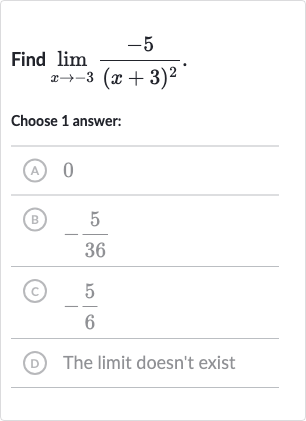Full solution
Q. Find .Choose answer:(A) (B) (c) (D) The limit doesn't exist
- Problem Analysis: We are asked to find the limit of the function as approaches . The function is a rational function, and we need to determine if the limit exists as approaches .
- Denominator Behavior: First, let's analyze the function as approaches . The denominator becomes when , which would make the function undefined at . However, we are interested in the limit as approaches , not the value of the function at .
- Numerator Behavior: Since the denominator is squared, it will always be positive for all except at where it is . As approaches from either side, the denominator approaches , but it does so in a positive manner because of the square.
- Combining Numerator and Denominator: The numerator of the function is , which is a constant. As approaches , the numerator remains unchanged.
- Limit Evaluation: Combining the behavior of the numerator and the denominator, as approaches , the denominator approaches positively, and the numerator stays at . This means the function's value will approach negative infinity because a negative number divided by a positive number that is getting closer and closer to will result in a value that becomes more and more negative.
- Conclusion: Therefore, the limit of as approaches does not exist because the function approaches negative infinity. The correct answer is (D) The limit doesn't exist.
More problems from Evaluate an exponential function
QuestionGet tutor help
QuestionGet tutor help
QuestionGet tutor help
QuestionGet tutor help
QuestionGet tutor help
QuestionGet tutor help
QuestionGet tutor help
QuestionGet tutor help
QuestionGet tutor help

